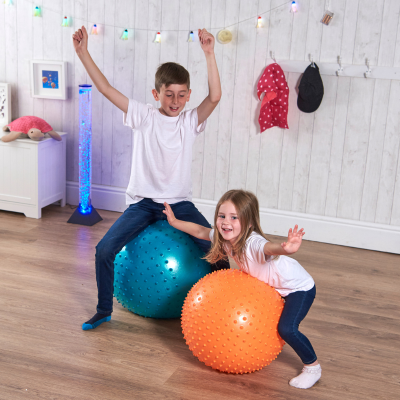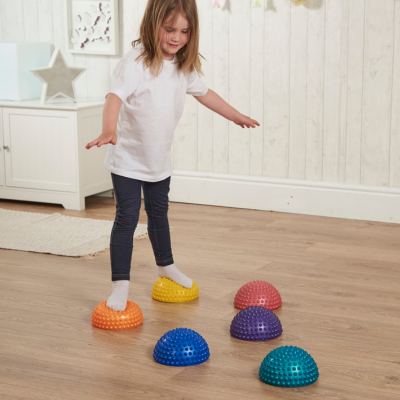Get exclusive deals you won't find anywhere else straight to your inbox.

10 Fun Balance Activities
We've explored reasons why your child may struggle with balance and the benefits of good balance skills. Now we're going to share with you some fun balance activities. These simple and easy balance activities can be done at home, in the park, on holiday or at school.
#1 Design an obstacle course
Obstacle courses are one of the easiest balance activities to do. They benefit children, teenagers and adults of all ages and abilities. Create a simple obstacle course that includes activities like hopping on one foot, walking on a line or stepping over objects. Adapt to your child's abilities and increase the difficulty as their balance improves. Best of all, you can create them with items already in the home! Great fun in the garden, or inside the house on rainy days. For some additional sensory feedback why not add a body sock to your obstacle course. Crawling under and climbing over things can be particularly fun in a body sock!
#2 Have fun with a scooter board
Scooter boards are great fun! Ask your child to sit or lie across a scooter board and use their hands or feet to move around. This type of movement helps with coordination, strength and balance. Why not try these balance activities with your scooter board?
- Sit on the scooter board and give yourself a big push. Lift your legs off the floor and see how far you balance before the scooter board stops
- Complete your obstacle course on your scooter board (indoors only)
- Follow a path of tape placed on the floor. Your child will have to use balance, coordination and gross motor skills to stay focused and on the scooter board
- Place toys or small objects in different places around the room, together with some boxes. Ask your child to collect the objects 1 at a time and place in the boxes. Their balance skills will be tested as they reach for and place the objects.

#3 Play catch
Playing catch with soft balls or bean bags is great for hand eye coordination and motor skills. Try sitting on a therapy ball and playing catch with a friend or family member. See how long you can balance whilst catching the ball. As your child's balance improves, throw from a longer distance, increasing the level of difficulty.
If you are new to therapy balls or find playing catch as well too difficult, you can also try lying on therapy balls. Gently rock back and forth in little movements to enhance balance and core stability. Once your child has their confidence try reaching for objects or simple bouncing to help build up good balance technique. For added sensory input why not try a sensory therapy gym ball. Covered in small bumps for tactile exploration.

#4 Walk the plank!
Does your child like pirates and adventure? Well me hearties it's time to walk the plank! Using a low balance beam or a backless bench, create a wooden plank that children can practice walking across. Pretend you're on a pirate ship and get them to 'walk the plank'. This helps improve coordination as well as balance, and who doesn't like pretending to be a pirate?
If you're worried about your child falling, you can do the same by placing sheets of paper across the floor (securing them so they can't slip) that your child must follow. Alterantively, why not try step-a-logs? A set of 6 sturdy colourful logs which provide an excellent gross motor activity for developing balance and direction.

#5 Take giant steps
Place stepping stones (which can be mats, pillows, or designated spots on the floor) for your child to walk across. Take giant leaps from one to another, and try not to fall off! This activity encourages balance and spatial awareness. Challenge a friend or family member to a race and see who can cross the stones the fastest, without falling off, or see who can do the most squats without loosing their balance. To make it more challenging, make the spaces between each stepping stone bigger. Our balance pods are great for this. With tactile nodes for additional sensory input you can create fun challenging course inside or outdoors.

#6 Seesaw rhythms
Seesaws, like the wippsider are brilliant, cost effective resources for improving balance. Portable and lightweight they are easy to use at home, in the park or even on holiday! Have your child create a rhythm with their movements. They can go up and down to the beat of a song, or create their own pattern, making the activity musical and rhythmic.
You can also try pass the ball. Whilst on the seesaw, pass a ball back and forth with your child. They can try to do this without dropping the ball or stopping the seesaw's motion.
It's also easy to incorporate simple exercises, like stretching their arms out to the sides, touching their toes, or doing gentle twists, to make the activity more physically engaging.

#7 Have a game of hopscotch
Hopscotch is a fantastic free game that can be played almost anywhere! Using chalk draw your hopscotch pattern on the floor and take it in turns to complete. These activities help with leg strength and coordination and make balance practice fun and engaging. Up the difficulty by placing bean bags, small toys or blocks on 1 or 2 of the numbered boxes. When your child lands on one of thoses boxes they have to bend down and pick up the object without falling over. Great for motor skills development and coordination.
#8 Stand on a wobble cushion
Stand on a wobble cushion on the floor. Yes you heard us right! Our wobble cushions are strong enough to be stood on and provide fantastic floor based balance aids as well as seating resources. See how long your child can stand on the wobble cushion before falling off, or try standing on one leg. You could even sit on it on the floor and hold your legs up. See how long you can maintain position and balance before falling off.
Our air board balance trainers encourage activities where you sit, stand or lie on the board. Ideal for strengthening muscles in the stomach, ankles, legs and upper body and suitable for children, teenagers and adults to use.

#9 Enjoy some team games
Have a good old fashioned egg and spoon race. Give each child a spoon and a small ball (or an egg). They need to walk from one point to another without dropping the ball. Increase levels of difficulty by creating a path to follow, or even an obstacle course if you're feeling particularly brave! A great team game for the whole family to enjoy, indoors or outside.
For more team game ideas why not try partner balance? Pair up with a friend or family member and have them try balancing on one foot while holding each other's hands. They can also try different poses, like one partner leaning back while the other leans forward. If you're feeling really confident, and your child is able to, why not try a tug of war, with a twist. Instead of a traditional tug of war, have kids hold onto a rope while standing on a balance board or wobble cushion. They need to pull gently without causing anyone to lose their balance. Who can get the rope over the line first, without falling off.
#10 Try yoga poses
Simple yoga poses such as Tree Pose, Warrior Pose, and Downward Dog can improve balance and concentration. Using visual aids or instructor guidance can help children understand and maintain poses. A quick online search will provide some basic yoga poses to try at home.
Conclusion
All of these activities can be adjusted in difficulty based on the age and skill level of the children, ensuring they are safe and enjoyable. Always try out activities under adult supervision and stop if your child becomes overwhelmed or are not enjoying themselves. Balance activities should be fun and engaging and a 'little and often' approach will really help engage more reluctant children.
If you have any more suggestions for fun balance activities, we'd love to hear from you!
By Andrew Caws, Managing Director, Sensory Direct
June 2024

